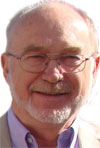
I confess it was 50 years ago when I started looking at new technology for sensors. Back then, colleagues and I updated the old WW2 mine detector, using really low frequency (i.e. 1 kHz) magnetic waves to discriminate between ferrous and non-ferrous items, and assess the size and range of the target by the signal phase measurement. Here the electronics used ‘modern’ operational amplifiers, on a ‘chip’.
The 1980s
Ten years on, in the ’80s, the technology coming into vogue was ultrasonics, replacing float systems to make liquid level switches, and then, still using analog electronics, the first Doppler ultrasonic flowmeter appeared. With the availability of digital microprocessor circuitry, timed pulses transmitted through the air down to the surface of a liquid led to non-contact liquid level measurement, and major success in the automation of sewage sump pumping systems. (The success lasted maybe 30 years, as when the mobile phone business created low cost microwave components, similar systems based on radar began to take over in this market.)
The next leap forwards in the mid-’80s was the time-of-flight ultrasonic flowmeter – actually achieved with discrete digital circuitry, which was faster than the available microprocessors. The technology was originally developed at Harwell, for measuring liquid sodium flows in nuclear reactors, but these flowmeters found major application in monitoring clean water flows, primarily in water distribution mains. Over the next 25 years the technique was picked up by commercial interests, and continually refined, introducing clamp-on sensor systems, and adapting the technique for gas flows as well. Even domestic gas meters were introduced using the same principle. Eventually the microprocessor speed became fast enough to achieve the flow measurement accuracy needed – using multiple sound paths – for the fiscal measurement of oil flows, which is now one of the major applications, along with similar gas flow measurement tasks.
Other sensors where I was not initially involved were in the fields of gas detection – where for flammable gases, Pellistors created a major business area – and fire detectors. It seems that UV and IR fire detection systems are still seeking the best approach. Possibly because of the awareness brought about by the Internet, the pace of change and the commercial opportunities, the large corporations are quick to acquire small spin-off companies from university or other research after any small success, because of what technology they may have discovered: they do this ‘just in case’, to protect their market position.
Current developments
The area I see as most important currently, and a fruitful area to flag up for research projects, is in any style of optical analytical measurement sensor. Specifically, the component that brought this into industrial instrumentation was the tuneable diode laser (TDL), developed prior to 2005 for the telecommunications industry, to transmit telephone conversations and data down fibre-optic cables. Around 2007 Yokogawa acquired a business from Dow Chemicals, which used TDL sensors for near-infrared absorption (NIR) measurements of a gas mixture, which gave the proportions of oxygen, carbon dioxide and monoxide, and water vapour. This allowed the unit to be used as a combustion analyser for industrial furnaces, boilers etc.
Over the last 10 years this area of technology has grown in importance, and in its capabilities. Spin-off companies have emerged from various universities, like Manchester and Glasgow. A significant task in these developments is the application of the solution to an industrial problem: it needs the two factors of solving both the technical design and the industrial application. Cascade Technologies was established in Glasgow in 2003, and their analysers were initially targeted at marine flue gas emissions monitoring. From 2013 they added a focus on pharmaceutical gaseous leak detection, and also the process industry, on ethylene plants. Their technology allows multiple gases to be measured simultaneously. The Cascade business has now been acquired by Emerson.

Another closely market-focused supplier of NIR analytical systems is TopNIR Systems of Aix en Provence, in France, actually a spin-off business from within BP. TopNIR use their systems to analyse hydrocarbons – both crude oil and processed products – to allow a refinery operator to know how to most profitably blend the available components into a final product, as well as to minimise any quality give-away in blending the different grades of gasoline and diesel. TopNIR quote the annual benefit to a typical refinery at $2 to $6 million, with an implied investment spend of up to $2 million!
Nick Denbow spent 30 years as a UK-based process instrumentation marketing manager, and then changed sides – becoming a freelance editor and starting Processingtalk.com. Avoiding retirement, he published the INSIDER automation newsletter for five years, and then acted as their European correspondent. He is now a freelance Automation and Control reporter and newsletter publisher, with a blog on www.nickdenbow.com

© Technews Publishing (Pty) Ltd | All Rights Reserved